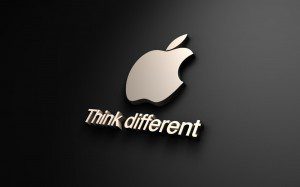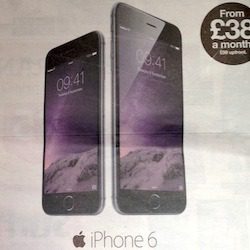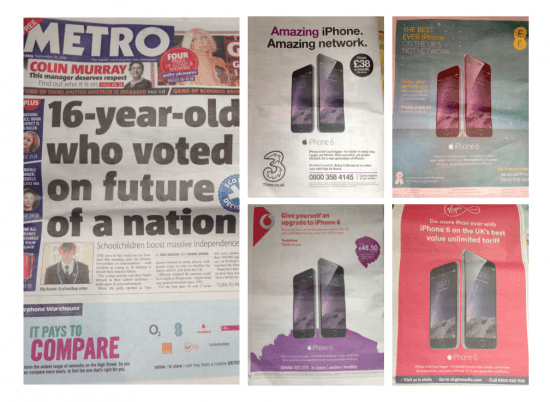There is nothing so tantalizing as looking at the Apple brand marketing strategy and thinking how to learn from them! But, is everything they do, a de facto lesson for other companies?
 Sure, Apple is the company with the world’s highest capitalization ($439B as of writing). This comes with some risks with regard to shareholder expectations. Yet, on the street (literally and virtually — although I’m not sure about Wall Street), Apple continues to enjoy unfathomable success. Every new release of a new iPhone and/or operating systems brings fantasmagorical media coverage, as well as a raft of bugs and “issues.” As any Applite will know, the pangs and pains of an upgrade are overcome by dint of effort, scrolling through forums, asking for friendly advice and investigative trial & error.
Sure, Apple is the company with the world’s highest capitalization ($439B as of writing). This comes with some risks with regard to shareholder expectations. Yet, on the street (literally and virtually — although I’m not sure about Wall Street), Apple continues to enjoy unfathomable success. Every new release of a new iPhone and/or operating systems brings fantasmagorical media coverage, as well as a raft of bugs and “issues.” As any Applite will know, the pangs and pains of an upgrade are overcome by dint of effort, scrolling through forums, asking for friendly advice and investigative trial & error.
The power of employee engagement
Apple is blessed with a brand that is both their commercial and corporate name. An employee of Apple Itunes is an employee of Apple above all. For some big consumer brands, this is not the case where, internally, sub-brands (i.e. commercial) vie against one another and the sense of belonging may be rudely split between the commercial brand and the corporate company (e.g. @ Procter & Gamble, Unilever, L’Oreal…). Apple’s employees are not just Apple users — which is never more obvious than in the Apple store. They are Apple enthusiasts and evangelists. For Apple to have achieved this level of employee engagement, it has a vibe (which we could broadly call a credo) where it has forever played the role of “the alternative,” a.k.a. sh*t stirrer. Aside from Jobs’ incarnated mission to make the world a better place, every Applite has a little bit of agent provocateur in them. It’s a binding force.
Distribution control
One could wax on about Apple’s singularly powerful store strategy, whereby they now own and operate (as of August 2014) 434 stores in just 16 countries. Their retail strategy is genuinely remarkable. It would seem that Angela Ahrendts, the new head of Apple retail, might only have the potential to screw it up. However, for this particular post, looking at the launch of the iPhone 6 in England, I was rather tempted to zoom in on the way Apple was featured in the media. Specifically, I looked at how the battle was waged in the two main free papers that are doled out each working day in London: Metro and the Evening Standard (which comes out at noon!). Below are the ads for the iPhone 6 as they appeared in Metro, on the day of launch (19 September 2014). There were four competing ads: Three, Virgin, EE and Vodafone. The main image and supporting “blah blah” about the phone were rigorously the same in each ad – an Apple mandate:
Iphone 6 isn’t just bigger – it’s better in every way. Larger, yet thinner. More powerful, yet power efficient. It’s a new generation of iPhone.”
Marketing strategy control
If Apple is able to manage with a firm hand its own store network, the control over distribution can only go so far, since it must also work with network operators to manage the mobile and Internet connection piece. As a result, the main operators with their retail outlets must ante up in the hysterical feeding frenzy and try to get their slice of the massive Apple pie. The different features put forward by the operators in the above creatives were decidedly meek and, as far as I was concerned, little distinguished. Here, in order of appearance in Metro, are the marketing texts specific to the operators. N.B. 3 of the 4 ads appear one after the other on the left-hand page (pages 6-8-10).
- Virgin – UK’s best value unlimited tariff. [without any mention of the price] page 8
- Vodafone – Give yourself an upgrade to iPhone 6, plus enjoy your choice of entertainment on Red 4G with unlimited minutes, texts and 10GB of data. From £48.50 a month and no upfront cost when you trade in a selected phone. page 10
- EE - UK’s No1 network. £40.99 a month on 4GEE. Cover your upfront cost when you trade in your current iPhone (normally £99.99). page 12
- Three – Amazing network. From £38 a month. £99 upfront. page 36.
If the message about the phone is consistent, the remaining arguments are much of a muchness. With such repetition, Apple is definitely the OTT winner. That said, it seems that the marketing arguments could have been managed with greater creativity. Other than Vodafone (which basically seems to have no value-added offer), they all claim to have the best (or a great) network. Without being able to avoid condemning the awful layout of the Vodafone ad (with the completely incongruous purple paint strokes), the marketing angle across these ads is essentially reduced to one of price on the monthly subscription.
Don’t do this at home, unless…
Apple has crafted a unique positioning and wields a unique power worldwide. Their brand strategy seems excessively desirable. However, the real takeaway for other companies is that you need to create a great brand before you can even think about operating in the same way as Apple does. Its dictatorial style is known to be barely appreciated among its distributor partners. Its buggy beta versions are always a test of users’ patience. The lofty stock price (and onhand cash) should make shareholders nervous. Yet, their products continue to be bought up voraciously. If the Apple model is not easily reproducible for the majority of companies, for the luxury sector, I continue to believe much could be learned.
Apple brand marketing strategy applied to luxury
Here are my top seven points that luxury brands could retain from the Apple brand marketing strategy:
- Consider carefully your mission, above and beyond just making money.
- Pay special attention to employee engagement around the brand’s values (i.e. with regard to who you hire and how you foster brand loyalty within the organization). N.B. If your commercial brand is not your corporate brand, this is a much trickier affair.
- Don’t sit on your laurels. Be obsessed with innovation in all areas of the business, not just with the product.
- Be bold (even if you are not a fan, Apple’s automatic distribution of the latest U2 album was quite brazen – and while it backfired, I like to see some edge and risk taking in the way such a big company operates).
- Be obsessed with the user experience. Make the product look good inside and out (in design conception, this can mean starting with the look & feel). The user experience needs a healthy marriage between aesthetics and functionality.
- Strive to control as much of your chain of communications and channel of distribution.
- Worry about the data (as in the owner’s personal data and financial details). The foray into mobile payment is, in my opinion, the most significant of Apple’s latest initiatives. [And this comes on the heels, ironically, of the major iCloud data breach]
What do you think? To what extent, some of the key learnings could be applicable to regular business in more downstream segments?













Trackbacks/Pingbacks